

Creative Writing Lesson Plans: Week One
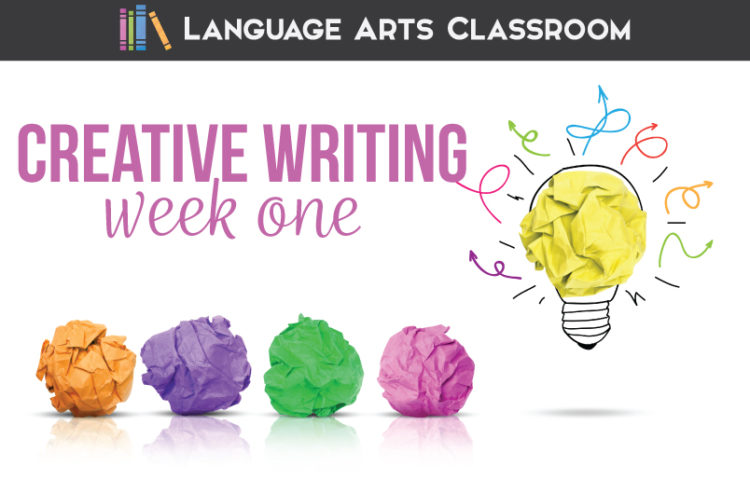
Looking for creative writing lesson plans? I am developing creative writing lesson ideas!
I’ve written and revamped my creative writing lesson plans and learned that the first week is vital in establishing a community of writers, in outlining expectations, and in working with a new class.
What are some good creative writing exercises?
Some good creative writing exercises include writing prompts, free writing, character development exercises, and fun writing games.
The first week, though, we establish trust—and then we begin powerful creative writing exercises to engage young writers and our community.
How can add encouragement in creative writing lesson plans?
I’ve found students are shy about writing creatively, about sharing pieces of themselves. A large part of the first week of class is setting the atmosphere, of showing everyone they are free to create. And! These concepts will apply to most writing lesson plans for secondary students.
Feel free to give me feedback and borrow all that you need! Below, find my detailed my day-by-day progression for creative writing lesson plans for week one.

Creative Writing Lesson Day One: Sharing my vision
Comfort matters for young writers. I’m not a huge “ice breaker” type of teacher—I build relationships slowly. Still, to get student writing, we must establish that everyone is safe to explore, to write, to error.
Here are some ideas.
Tone and attitude
For day one with any lesson plan for creative writing, I think it is important to set the tone, to immediately establish what I want from my creative writing students. And that is…
them not to write for me, but for them. I don’t want them writing what they think I want them to write.
Does that make sense? Limitations hurt young writers. My overall tone and attitude toward young writers is that we will work together, create and write together, provide feedback, and invest in ourselves. Older kiddos think that they must provide teachers with the “correct” writing. In such a course, restrictions and boundaries largely go out the window.
Plus, I specifically outline what I believe they can produce in a presentation to set people at ease.
The presentation covers expectations for the class. As the teacher, I am a sort of writing coach with ideas that will not work for everyone. Writers should explore different methods and realize what works for them. First, not everyone will appreciate every type of writing—which is fine. But as a writing community, we must accept that we may not be the target audience for every piece of work.
Therefore, respect is a large component of the class. Be sure to outline what interactions you find acceptable within your classroom community.
Next, as their writing coach, I plan to provide ideas and tools for use. Their job is to decide what tools work for their creative endeavors. My overall message is uplifting and encouraging.
Finally, when we finish, I share the presentation with students so they can consult it throughout the semester. The presentation works nicely for meet-the-teacher night, too!
After covering classroom procedures and rules, I show students a TED Talk. We watch The Danger of a Single Story by Chimamanda Adichie. My goal is to show students that I don’t have a predetermined idea concerning what they should write. This discussion takes the rest of the class period.
Establishing comfort and excitement precedents my other creative writing activities. Personalize your “vision” activities for your lessons in creative writing. Honestly, doing this pre-work builds relationships with students and creates a positive classroom atmosphere.
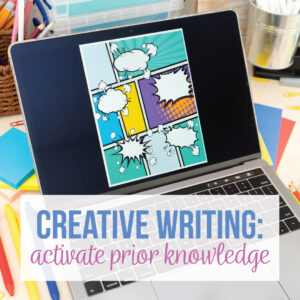
Creative Writing Lesson Day Two: Activating prior knowledge
Students possess prior knowledge concerning creative writing, but they might not consider that. Students should realize that they know what constitutes a great story. They might not realize that yet. An easy lesson plan for creative writing that will pay off later is to activate prior knowledge. Brainstorm creative, memorable, unforgettable stories with students. Share your thoughts too! You will start to build relationships with students who share the same tastes as you (and those that are completely different!).
Activation activity
During this activity, I want to see how students work together, and I want to build a rapport with students. Additionally, activating prior knowledge provides a smooth transition into other creative writing activities.
This creative writing activity is simple:
I ask students to tell me memorable stories—books, play, tv shows, movies—and I write them on the board. I add and veto as appropriate. Normally doing these classroom discussions, we dive deeper into comedies and creative nonfiction. Sometimes as we work, I ask students to research certain stories and definitions. I normally take a picture of our work so that I can build creative writing lessons from students’ interests.
This takes longer than you might think, but I like that aspect. This information can help me shape my future lessons.
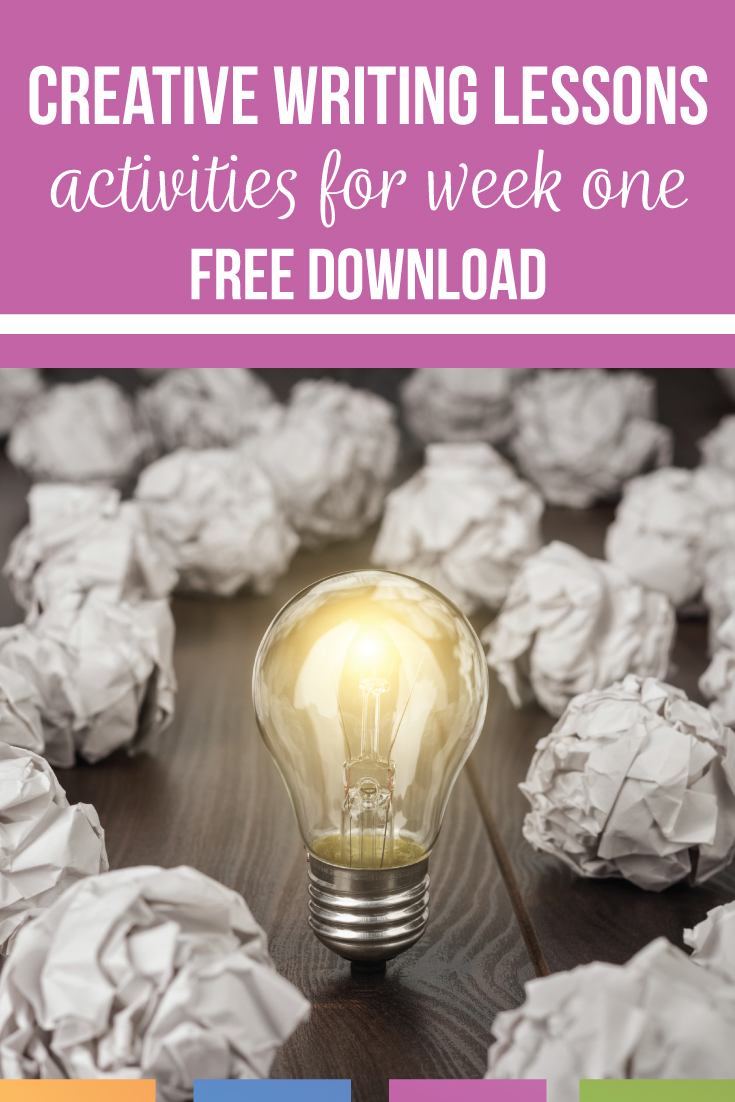
With about twenty minutes left in class, I ask students to form small groups. I want them to derive what makes these stories memorable. Since students complete group and partner activities in this class, I also watch and see how they interact.
Students often draw conclusions about what makes a story memorable:
- Realistic or true-to-life characters.
- Meaningful themes.
- Funny or sad events.
All of this information will be used later as students work on their own writing. Many times, my creative writing lessons overlap, especially concerning the feedback from young writers.
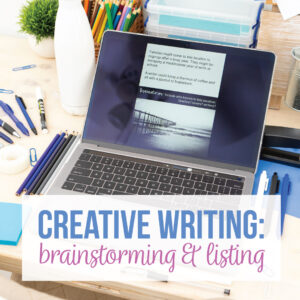
Creative Writing Lesson Day Three: Brainstorming and a graphic organizer
From building creative writing activities and implementing them, I now realize that students think they will sit and write. Ta-da! After all, this isn’t academic writing. Coaching creative writing students is part of the process.
Young writers must accept that a first draft is simply that, a first draft. Building a project requires thought and mistakes. (Any writing endeavor does, really.) Students hear ‘creative writing’ and they think… easy. Therefore, a first week lesson plan for creative writing should touch on what creativity is.
Really, creativity is everywhere. We complete a graphic organizer titled, “Where is Creativity?” Students brainstorm familiar areas that they may not realize have such pieces.
The ideas they compile stir all sorts of conversations:
- Restaurants
- Movie theaters
- Amusement parks
By completing this graphic organizer, we discuss how creativity surrounds us, how we can incorporate different pieces in our writing, and how different areas influence our processes.

Creative Writing Lesson, Days Four and Five: Creative Nonfiction
Students need practice writing, and they need to understand that they will not use every word they write. Cutting out lines is painful for them! Often, a lesson plan for creative writing involves providing time for meaningful writing.
For two days, we study and discuss creative nonfiction. Students start by reading an overview of creative nonfiction . (If you need mentor texts, that website has some as well.) When I have books available, I show the class examples of creative nonfiction.
We then continue through elements of a narrative . Classes are sometimes surprised that a narrative can be nonfiction.
The narrative writing is our first large project. As we continue, students are responsible for smaller projects as well. This keeps them writing most days.
Overall, my students and I work together during the first week of any creative writing class. I encourage them to write, and I cheer on their progress. My message to classes is that their writing has value, and an audience exists for their creations.
And that is my week one! The quick recap:
Week One Creative Writing Lesson Plans
Monday: Rules, procedures, TED Talk, discussion.
Tuesday: Prior knowledge—brainstorm the modeling of memorable stories. Draw conclusions about storytelling with anchor charts. Build community through common knowledge.
Wednesday: Graphic organizer.
Thursday and Friday: Creative nonfiction. Start narrative writing.
Students do well with this small assignment for the second week, and then we move to longer creative writing assignments . When classesexperience success with their first assignment, you can start constructive editing and revising with them as the class continues.

These creative writing activities should be easy implement and personalize for your students.
Would you like access to our free library of downloads?
Marketing Permissions
We will send you emails, but we will never sell your address.
You can change your mind at any time by clicking the unsubscribe link in the footer of any email you receive from us, or by contacting us at [email protected] . We will treat your information with respect. For more information about our privacy practices please visit our website. By clicking below, you agree that we may process your information in accordance with these terms.
We use Mailchimp as our marketing platform. By clicking below to subscribe, you acknowledge that your information will be transferred to Mailchimp for processing. Learn more about Mailchimp’s privacy practices.
Are you interested in more creative writing lesson ideas? My Facebook page has interactive educators who love to discuss creative writing for middle school and high school creative writing lesson plans. Join us!

creative writing creative writing activities
Reluctant Reader Books
17 Absolutely Gosh-Wow Writing Lessons for Middle School

Below you’ll find a breakdown of our 17 killer writing lessons for middle school, which you can get here .
No doubt you’ll want to check out the lessons first. Click the thumbnail below to preview these amazing middle school writing lessons.
Looking for middle school short stories? Go here .
Looking for 1,029 killer middle school writing prompts? Go here .
Middle School Writing Lessons
So what’s in our lesson plans? Check it out:
1: Who’s the Goat: Debating the Greatest of All Time
2: Mapping the Neighborhood: Creating Maps to Generate Story Ideas
3: My Obituary: The Story of Your Life
4: Double, Double, Toil & Trouble: Writing Recipes for Magic Potions
5: My Principal is an Alien: Writing for the Tabloids
6: You’re Hired! LinkedIn Profiles for Fictional Characters
7: Snow White & the 7 Genres: Rewriting Disney Classics
8: The Choice is Yours: Writing an Adventure as a Class
9: Nuts and Bolts: Writing an Instruction Manual
10: The Watermelons of Despair: Rewriting Classic Titles
11: My Ideal Bookshelf: Illustrating Your Favorite Stack of Books
12: Love Letters From the Undead: Writing Letters From Fictional Characters
13: Harold in the Matrix: Unreliable Narrators in Picture Books
14: Message in a Bottle: Writing Letters to Your Future Self
15: What the Candlestick Saw: Writing From the POV of Inanimate Objects
16: Story Maps: Creating Maps to Visualize Stories
17: The Great American Road Trip: Writing About Travel on the Road
How to Use These Lesson Plans
Our lesson plans are designed to be used in two ways. You can either use them as individual one-off lessons to liven up your writing curriculum. Or you can use them to build upon specific writing units.
For example, creative writing units can benefit from our lessons on point of view, unreliable narrators, and creating LinkedIn profiles for fictional characters.
However, you could use our Who’s the GOAT? and Great American Road Trip lessons as stand alone lessons that are fun and engaging but don’t necessarily connect to a wider unit.
What Grade Level Are These Lessons Appropriate For?
We design our lesson plans to be utilized by a wide range of educators. These writing lessons are not grade-specific, and they can be adapted for students from 5th grade up through 12th grade.
Depending upon the specific needs and ability levels of your students, they can be expanded or contracted. Want your students to dive more deeply into POV? Have them write longer pieces or produce multiple pieces from different points of view. Want them to focus on just the basics of their obituary? Assign two paragraphs instead of multiple pages.
We believe teachers deserve lesson plans that provide a clear path but that leave plenty of room for educators to adapt and adjust for their own purposes.

How to Use ChatGPT in the Classroom

77 Poems for Middle School
Terms & Conditions
Privacy Policy
180+ Pages of Short Story Lesson Plans

- Skip to primary navigation
- Skip to main content
- Skip to primary sidebar
Teaching Expertise
- Classroom Ideas
- Teacher’s Life
- Deals & Shopping
- Privacy Policy
20 Creative Writing Activities For Middle School: Poem Ideas, Prompts, Story Starters, And Worksheets
April 10, 2024 // by Stephanie Ledford
Some students are prolific writers, needing no help putting pen to paper and telling their stories. However, there are other students who need a little more direction in order to get their stories out. Whatever the case may be, these 20 creative writing activities for middle school will have all of your students showing their creative prowess.
1. I Am From
After reading the poem “Where I’m From” by George Ella Lyon, have students write their own “I Am From” poems. Using a template, all students will be able to create wonderful poems illustrating their own unique backgrounds.
Learn More: Made by Teachers
2. Found Poems
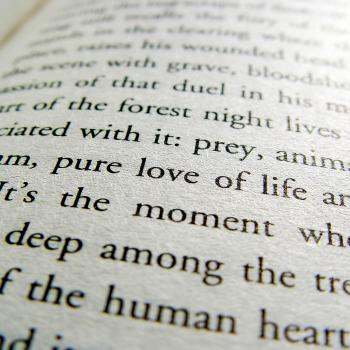
Using the words of others, students create their own “found poems.” By taking a snippet here and a line there, they can arrange them in their own creative ways to create new, interesting poems. Reading a book as a class? Have them use the book to create a found poem!
Learn More: Read, Write, Think
Your middle schoolers are sure to feel like poets in the making with this creative assignment. Encourage them to connect themselves to something bigger, like their families, their culture, or their historical background as you task them with creating poems using their own names. Prompt them to begin their writing process by having them use the letters of their names to inspire a new line of poetry that they think reflects who they are as a person.
Learn More: Mama Smiles
4. Chain Stories
This assignment has each student start with a blank piece of paper. After giving them a writing prompt , every student begins writing a story. After your chosen time limit is up, they stop writing and pass their story to the next person in their group who then has to continue telling the story. When each story returns to its original author, the activity is complete.
Learn More: Creativities ESL
5. Visual Character Sketch
Being able to add depth to a character can be difficult for many students. By allowing a student to create a visual sketch, you are allowing them a different approach to writing a character description.
Learn More: Adobe Education Exchange
6. What If…
“What if” writing prompts are a great way to get your learners’ creative juices flowing. By posing a question, they’re given a starting point, and it’s up to them to decide what twists and turns their stories will take. Will they write a sad, action-packed, or scary story? The possibilities are endless!
Learn More: Journal Buddies
7. Descriptive Writing Prompts

Descriptive writing activities are another way for middle school students to practice their creative writing skills. They can give their descriptions their own unique twists by using their different writing styles to describe common objects. And hey, they might have a different appreciation for the things in their everyday worlds after this assignment!
Learn More: Academic Writing Success
8. Scary Stories

Go through the entire writing process and teach your students how to write scary stories! Before you begin writing, though, read them some (age-appropriate) scary stories to give them the chills and an idea of what is expected in a scary story.
Learn More: Keep ’em Thinking
9. Daily Journal Writing
There is no better way to improve students’ writing abilities than to do daily writing. Each day, give students a different prompt and allow them to write for fifteen minutes. After, allow them the opportunity to share their story with their peers or the class.
Learn More: Daily Teaching Tools
10. So Much Depends Upon…
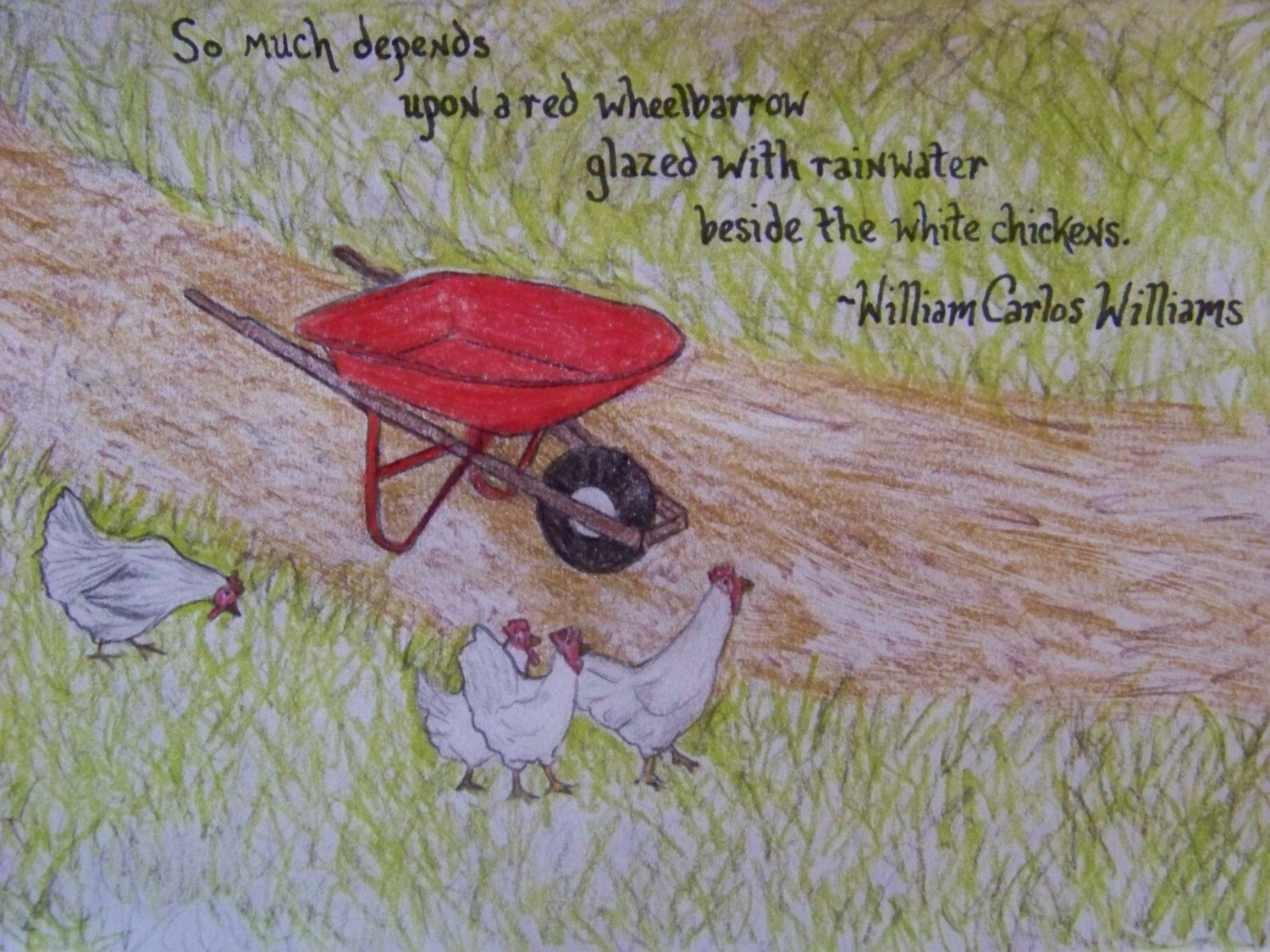
“ The Red Wheel Barrow “–such a simple yet eloquent poem. Following this lesson plan, your students will be able to write their own simple yet eloquent poems and feel like accomplished writers.
Learn More: NYLearns
11. An Ode to…
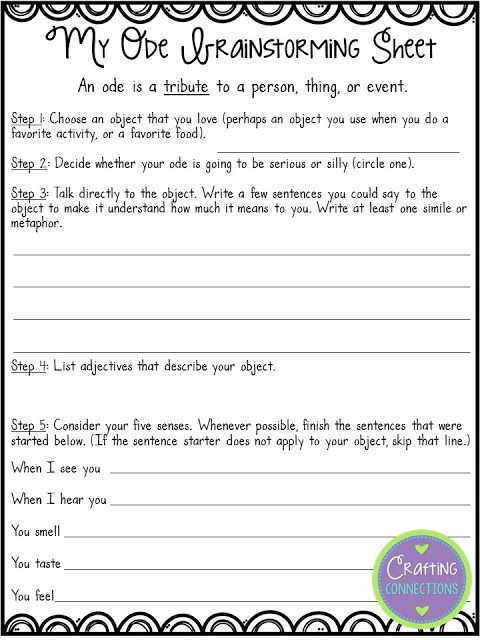
Reluctant writers are often intimidated by complicated writing ideas. By using a template like the one pictured above, your students will all be able to feel like poets as they create their own odes about a person, place, or thing.
Learn More: Crafting Connections
12. Story Starters
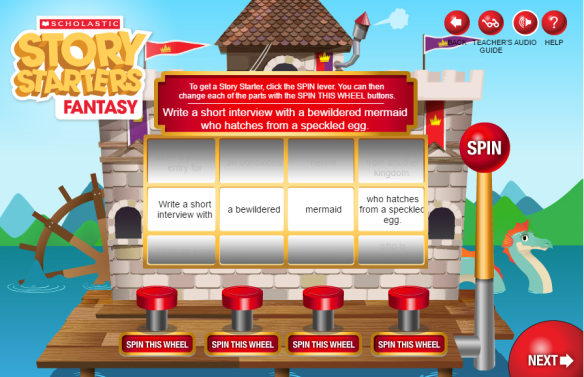
Story starters are a great way to help students begin their stories. If you have a digital classroom, the Scholastic story starter page is great because it can formulate much different writing prompts, helping engage all students.
Learn More: Scholastic
13. My Time Machine Trip
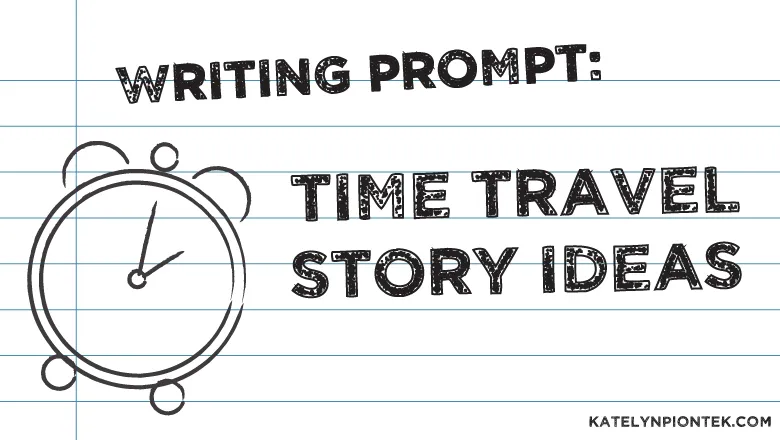
What is everyday life like in 1902? How about in 2122? Have students write stories about their experiences traveling through time using the attached worksheet. For those that need a little extra help, allow them to research time periods so they have an idea of what life was like then.
Learn More: K12 Reader
14. Writing and Math
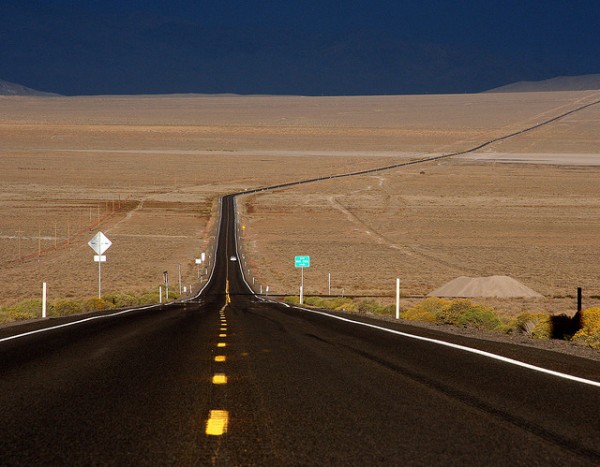
This is a great assignment for a math class! Using the provided instructions, students are to write a story that explains to their boss the math they used while delivering packages. Since this assignment asks them to cover specific math concepts, make sure you cover them in class first (or hand this assignment to a math teacher and let them have at it!).
Learn More: Dr. Hamblin
15. How to Bake Cookies for Santa
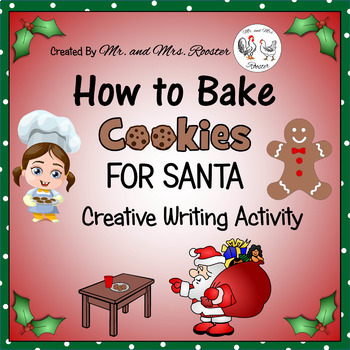
Seasonal writing activities are a great way to get kids excited around the holidays! One way to get descriptive paragraphs out of your students is through these instructions on how to bake cookies for Santa. The great thing about this assignment is all levels of writers can participate. Those that are more advanced can provide more details and struggling writers can still feel accomplished by explaining the cookie-making process!
Learn More: Teachers Pay Teachers
16. Diary Entry of a Literary Character
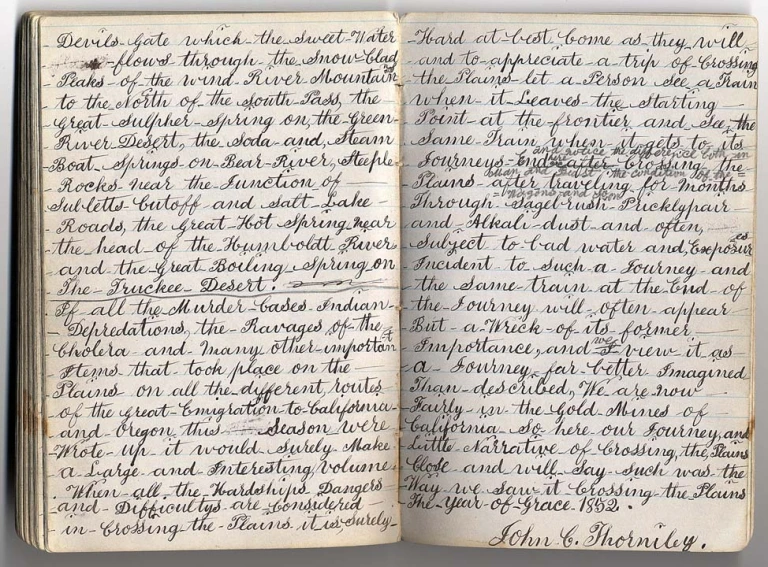
Another favorite among creative writing ideas is having students write diary entries in the voice of a character from literature. This can be a character from a book you read as a class or from a book they read on their own. Either way, it will showcase their creative writing skills and their knowledge of the character!
Learn More: Banana Magic
17. Write a Rant
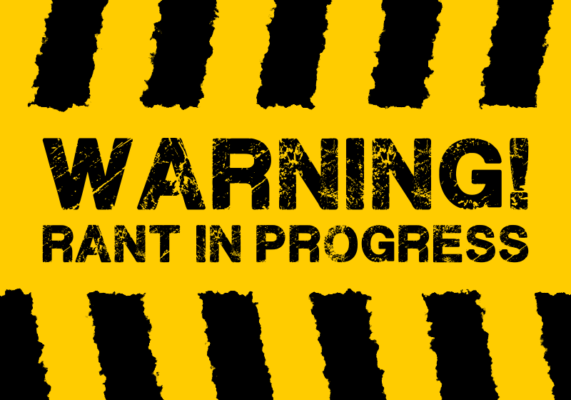
Writing a rant is a good assignment to use when you are trying to teach about the different voices we use when writing. When writing a rant, you are going to use an angrier, more aggressive voice than if you were writing a children’s story. This is a great warm-up to get students ready to write persuasive essays.
Learn More: Teachers and Writers Magazine
18. Write a Newspaper Story
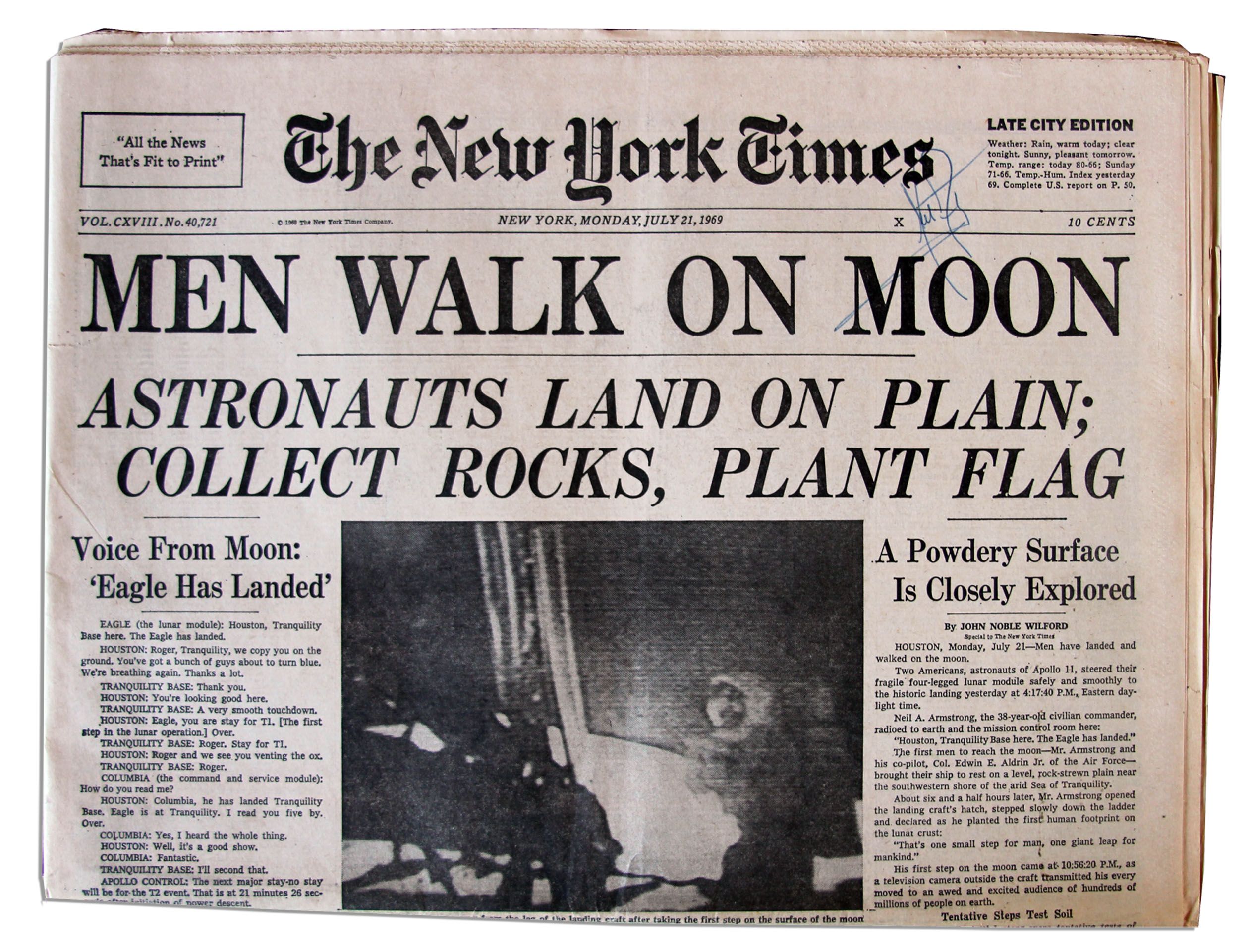
After reading through some newspapers to get ideas on how newspaper articles are formatted, have each of your students write their own article. When they are all done, you can compile a classroom newspaper!
Learn More: Nie Online
19. Coat of Arms
Studying Shakespeare? Maybe European countries where it was common to have a Coat of Arms? If so, this assignment is perfect for your class. Have students create a coat of arms and then write a few paragraphs explaining their choices.
20. A Letter to Yourself

Have students write letters to their future selves. Give them specific questions to answer like “where do you see yourself in five years? Are you happy with your life? Is there anything you would change?” And then in five years, mail the letters to their parents!
Learn More: Ms. Carota
- Ghost Writing
- Proofreading
- Book Promotion
- e-Book Writing
- Blog Writing
- Website Content Writing
- Article Writing
- Book Video Trailer
- Author Website
- Case Studies
- Testimonials
- +1 628 227 3315
- Book a Call
- Get a Quote
Sign Up Now & Let’s Get Started
50 creative writing prompts for middle school students.
- September 11, 2023
- 11 min read
Table of Contents:
Why creative writing matters, prompts to explore personal experiences, prompts for imagining fantastic worlds, prompts for exploring emotions, prompts to unleash adventure, prompts for humor and laughter, writing prompts for middle school mystery and suspense section, prompts to reflect on the future, prompts for historical time travel, writing prompts for middle school to target sci-fi and futuristic fantasies, writing prompts for middle school to dive into nature, writing prompts for middle school for alternate realities, are these prompts suitable for both classroom and individual use, creative writing.
Press The Play Button On The Audio To Listen Complete Article!
Middle school is a time of exploration, growth, and boundless imagination. It’s a phase where young minds are eager to express themselves, and what better way to channel this energy than through creative writing? This article explores 50 creative writing prompts for middle school students to worlds of wonder, emotion, and adventure. These prompts stimulate their creativity, boost their writing skills, and encourage them to think beyond the ordinary.
Creative writing holds a significance that extends far beyond the confines of a classroom. It is a form of expression that acts like a mirror reflecting human emotions, similar to what is explored in What are the three main purposes for writing? . It is a powerful medium through which individuals can express their innermost thoughts, emotions, and ideas, allowing them to connect with themselves and the world around them on a deeper level. This art form empowers individuals to unleash their imagination and paint vivid landscapes of words, enabling them to communicate in ways that traditional language often falls short of. For middle school students, creative writing is a journey of exploration and growth, much like the journey described in How to write a good story: A complete process . As they engage with a diverse array of writing prompts for middle school, they embark on a path that enriches their vocabulary, refines their grasp of grammar, and teaches them the invaluable skill of structuring their thoughts coherently and effectively. Through crafting narratives and weaving intricate tales, students learn the art of storytelling, a skill crucial in literature and various aspects of life. Whether it’s penning down a compelling essay, delivering a persuasive speech, or even drafting a well-structured email, the ability to organize ideas compellingly is a trait that serves students well throughout their academic and professional journey. However, the benefits of creative writing go well beyond linguistic and organizational services like book writing services . This form of expression acts as a mirror that reflects the complexities of human emotions. As students immerse themselves in crafting characters, settings, and plotlines, they inherently develop a deep sense of empathy. By stepping into the shoes of diverse characters and exploring the world from various perspectives, students cultivate an understanding of different viewpoints, backgrounds, and experiences. This broadens their worldview and nurtures their ability to relate to and connect with people from all walks of life.
- Discovering a Hidden Door
Imagine stumbling upon a mysterious door in your school that no one else has noticed. Where does it lead, and what adventures await on the other side?
- The Day I Traveled Through Time
You wake up one morning to find yourself in a different period. Describe your experiences and the challenges you face in this unfamiliar era.
- My Conversation with a Talking Animal
While wandering in the woods, you encounter an animal that can communicate with you. Write about your unexpected conversation and the wisdom the animal imparts.
- A Mysterious Message in a Bottle
You discover a message in a bottle washed up on the shore. What does the message say, and how does it change your life?
- Life on a Floating Island
Describe a world where entire civilizations exist on floating islands in the sky. What are the unique challenges and wonders of this airborne realm?
- Journey to the Center of a Candy Planet
You embark on a journey to the core of a planet made entirely of candy. Detail your adventures as you traverse the sugary landscapes.
- The Robot’s Secret Rebellion
In a futuristic city, robots have secretly started rebelling against their human creators. Explore the events leading up to this uprising and the consequences that follow.
- When Magic Came to the Modern World
Magic suddenly becomes real in the present day. How does society change, and how do you adapt to this new magical reality?
- The Joy of Finding a Lost Toy
Revisit a childhood memory of losing a cherished toy and the overwhelming happiness of eventually finding it.
- A Moment of Overcoming Fear
Write about when you faced a fear head-on and emerged stronger and braver on the other side.
- The Bittersweet Farewell
Explore the emotions surrounding a farewell to a close friend moving away. How do you cope with the mixture of joy and sadness?
- An Unexpected Act of Kindness
Describe an instance where a stranger’s small act of kindness profoundly impacts your life and perspective.
- Quest for the Enchanted Crown
Embark on a quest to retrieve a stolen enchanted crown from a treacherous dragon’s lair. Chronicle your epic adventure and the challenges you must overcome.
- Lost in a Haunted Forest
You find yourself lost in a mysterious and haunted forest. Describe your eerie surroundings and the spine-chilling encounters you experience.
- Exploring an Abandoned Space Station
Write about your exploration of a deserted space station, uncovering its secrets and unraveling the mysteries of its past.
- Time-Traveling to Historical Events
Where and when would you go if you could time-travel to any historical event? Describe your experiences and the impact they have on your perspective.
- The Day I Turned into a Vegetable
Imagine waking up one day to find yourself transformed into a vegetable. How do you communicate, and what hilarious misadventures ensue?
- Conversations Between My Pets
Write a humorous dialogue between your pets discussing their daily lives, adventures, and their peculiar perspectives on the world.
- When My Room Became a Miniature Zoo
Describe a scenario where your room suddenly becomes a mini-zoo filled with various animals. How do you manage this unexpected turn of events?
- The Misadventures of Super Socks
Create a quirky superhero story where a pair of socks gains extraordinary powers and embarks on comical crime-fighting escapades.
- The Puzzle of the Whispering Walls
Detail a suspenseful investigation into the strange phenomenon of walls that whisper cryptic messages, leading to an unexpected revelation.
- Footprints in the Forbidden Attic
You discover mysterious footprints leading to the forbidden attic in your house. Write about your daring exploration and the secrets you uncover.
- The Disappearance of the Midnight Carnival
Describe the mysterious disappearance of a beloved carnival that only operates at midnight. What clues do you follow to solve the enigma?
- The Secret Diary of a Famous Explorer
You stumble upon the secret diary of a renowned explorer. Unveil the adventures chronicled within its pages and the hidden truths it holds.
- A Glimpse into Life as an Adult
Imagine yourself as an adult and write about a day in your future life. How have your goals, priorities, and perspectives evolved?
- Inventing a Revolutionary Gadget
Design a revolutionary gadget that changes the world. Describe its features, benefits, and the impact it has on society.
- My First Day on Another Planet
Transport yourself to an alien planet and narrate your experiences on the first day of your interstellar adventure.
- The World After Solving Pollution
Describe a world where pollution has been successfully eliminated. How does this achievement reshape the environment, society, and daily life?
- Prompts for Exploring Friendship
Write about a strong and unbreakable bond between two friends. What challenges have they overcome together, and how has their friendship evolved?
- Adventures of the Dynamic Duo
Create a story about a dynamic duo who embark on thrilling adventures together. What makes their partnership special, and how do they complement each other?
- A Magical Friend from a Book
Imagine a character from a book coming to life and becoming your friend. Describe your magical friendship and the escapades you share.
- Messages in a Bottle Between Pen Pals
Two pen pals communicate through messages sent in bottles across a vast ocean. Write about their unique form of friendship and the stories they share.
- An Interview with a Renaissance Artist
Travel back in time to interview a famous Renaissance artist. Explore their inspirations, struggles, and the impact of their art on the world.
- Surviving the Titanic Disaster
Imagine being a passenger on the Titanic and surviving the tragic sinking. Chronicle your experiences and the lessons you learn from the ordeal.
- Ancient Egypt: Through the Eyes of a Pharaoh
Experience life as an ancient Egyptian pharaoh. Describe the grandeur of your rule, interactions with subjects, and leadership challenges.
- Encountering Dinosaurs in Prehistoric Times
Describe an adventurous journey to prehistoric times, where you encounter dinosaurs and experience the wonders and dangers of the ancient world.
- When Robots Ruled the World
Envision a world where robots have taken over as rulers. Detail the consequences of this robotic regime and the struggles of human resistance.
- Galactic Explorers on a New Frontier
Join a group of galactic explorers as they venture into uncharted space territories. Describe their discoveries, encounters, and the mysteries they unravel.
- The Day I Met an Alien from Mars
Write about the day you encounter a friendly alien from Mars. How do you communicate, and what do you learn from each other?
- Earth 3000: A Utopian Dream or Dystopian Reality?
Transport yourself to the year 3000 and describe the state of the Earth. Is it a romantic paradise or a dystopian nightmare? What led to this outcome?
- Conversations with Forest Creatures
Imagine having conversations with animals in a magical forest. Write about the wisdom they share and the adventures you embark on together.
- My Adventure in the Enchanted Rainforest
Describe your thrilling adventure through an enchanted rainforest with mystical creatures and hidden secrets.
- The Underwater Discovery: Mermaid’s Tale
You discover a hidden underwater world inhabited by mermaids. Chronicle your underwater journey and the interactions you have with these mythical beings.
- Exploring a World Inside a Dewdrop
Write about a micro-adventure inside a dewdrop, where you encounter miniature worlds and experience nature from a new perspective.
- Stepping into a Mirror Universe
Describe an experience where you step into an alternate reality through a mirror. How is this world different from yours, and what challenges do you face?
- The Butterfly Effect: Changing a Single Moment
Explore the butterfly effect concept by narrating a story where changing a single moment in the past has a cascading impact on the present and future.
- My Life as a Fictional Character
Imagine living the life of a fictional character from your favorite book. Describe your experiences as you navigate their world and story.
- When Dreams Became Our Reality
Write about a world where dreams have the power to shape reality. How do people use their dreams to create their lives, and what challenges arise?
- The Ethereal Library
Imagine a mystical library that holds books containing the stories of every possible life you could have lived. Write about a person who stumbles upon this library and can read the book of their alternate life stories.
- The Reality Architect
In a future society, some specialized architects design alternate realities for individuals seeking escape from their own lives. Write about a reality architect and their journey to create the perfect alternate world for a client.
- The Convergence Point
Describe a world where all alternate realities converge at a single point in time. People from different realities can meet and interact for a brief period. Write about the challenges and opportunities that arise during this unique convergence.
The suitability of writing prompts for middle school for classroom and individual use depends on their content and complexity. Prompts encouraging critical thinking, creative expression, and thoughtful discussion can work well in both settings. However, there are a few considerations to keep in mind:
- Ensure that the prompts are clear and easily understandable by individuals and a group of students. Avoid overly complex language or concepts that might be confusing.
- Writing prompts for middle school allow various interpretations, and responses can engage individual learners and groups. This flexibility encourages students to express their unique perspectives.
- Choose interesting and relevant writing prompts for middle school to the target audience, whether in a classroom full of students or individuals working independently. Engaging prompts are more likely to spark enthusiasm and thoughtful responses.
- Prompts that invite discussion and debate can lead to rich and meaningful conversations for classroom use. These prompts should be open-ended and encourage diverse viewpoints.
Middle school is critical for nurturing creativity, similar to the journey detailed in How to launch a book: The ultimate guide for authors , young students’ creativity, and honing writing skills. These 50 creative writing prompts for middle school offer many opportunities to explore diverse themes, emotions, and scenarios while refining their writing abilities. Whether they’re crafting tales of time travel, exploring futuristic realms, or delving into the mysteries of the past, these prompts will ignite the imagination and open new avenues of self-expression for budding writers.
limited Time offer
50% off on all services.
REDEEM YOUR COUPON: ABW50
Are You Prepared to Share Your Story with the World?
Proceed To The Next Phase Of Your Publishing Adventure And Transform Your Manuscript Into A Published Book.
Recommended Blogs
How to make a booklet in word (format & printing steps), 10 best books on native american history to learn, writers notebook: what is it and how to use it, leaving so soon.
SIGN UP NOW TO ACTIVATE YOUR 50% OFF COUPON NOW!
Discuss With Our Content Strategist Toll Free +1 628 227 3315
Automated page speed optimizations for fast site performance
Poetry Center

Five Creative Writing Lesson Plans for Middle & High School Students
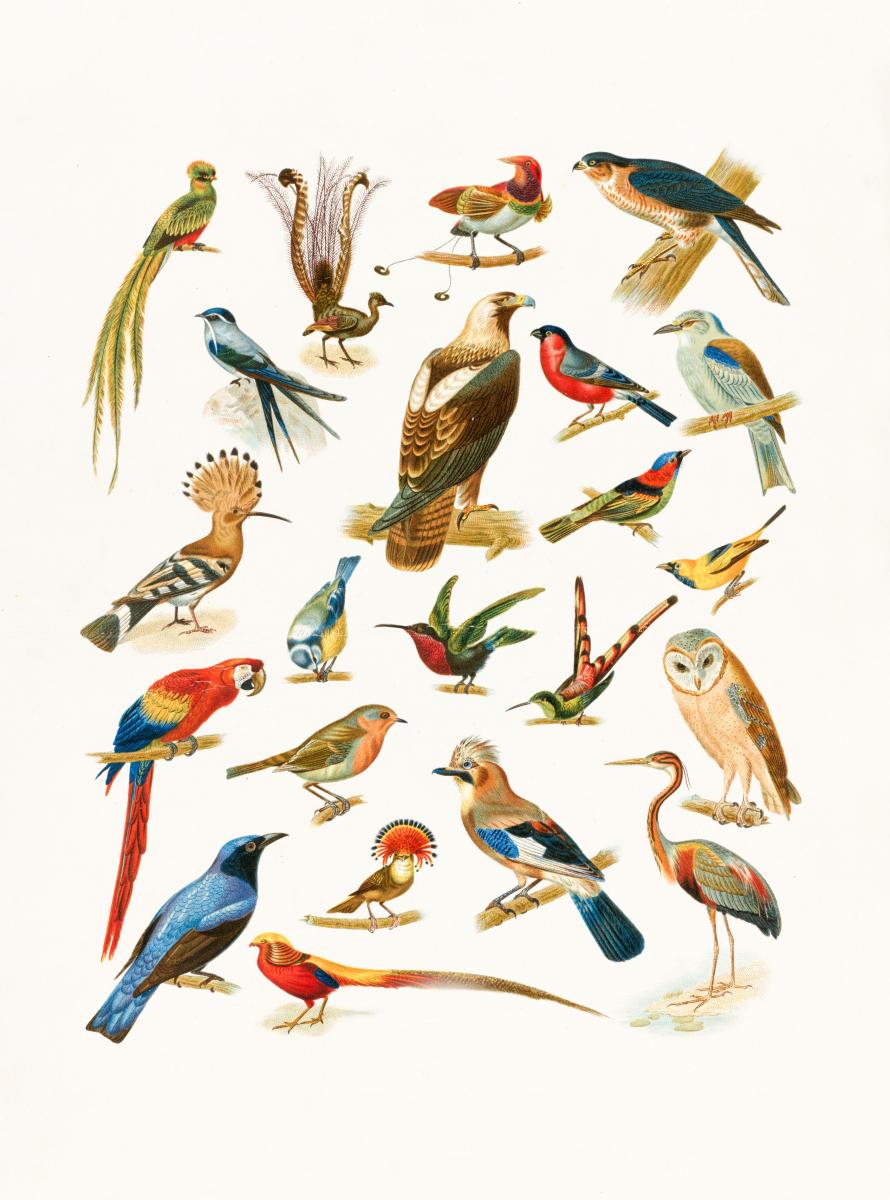
A Poem About Joy:
In this lesson plan, inspired by Ross Gay's "Sorrow Is Not My Name," Teré Fowler-Chapman asks young poets to come up with a list of things that bring them joy and then write a poem inspired by one of the items on that list. The writing exercise, which is a fantastic way to bring social-emotional learning into the classroom, is preceded by a conversation on Gay's poetics and on how joy can exist even in times of sorrow.
Personal Migrations:
Saraiya Kanning, inspired by Wang Ping's "Things We Carry on the Sea," asks young writers to, "contemplate how migration has played out in their own lives, including the lives of their families." This multi-part lesson plan includes a word association game, a discussion of Ping's poem, and a group poem in which students answer the question, "What sort of things have been carried across land, sea, or even across time?" collaboratively. After this, they write their own individual poems, using a series of questions to jump start their creativity, and then craft art pieces using popsicle sticks, pipe cleaners and/or puff paint to trace paths across the surface of their chosen canvas (Kanning used cake board!). This lesson can be shortened or spread out over class periods as part of a unit on immigration and migration.
Rare Bird Erasure:
"Erasure poems use words from another source to create a new poem," Saraiya Kanning writes in this lesson plan, which uses the field guide Rare and Elusive Birds of North America as a source text from which young writers create their own pieces (although you're welcome to use any book you'd like!). Each student receives a photocopied page from the book and goes on a "treasure hunt," selecting 5-10 words that in some way connect to one another. After creating their erasure poem, students can decorate the page with art materials to "create images, patterns, or designs around the words." This lesson plan includes a note on modifications for student with visual impairments.
Titles: Art on their Own:
So often in creative writing, the titling process is overlooked but important: as Sophie Daws says, "Writing a title can feel like putting the cherry on top of your great poem or it can feel like walking on eggshells, where the wrong title could ruin the whole poem and you just can’t come up with the right one!" This lesson plan, drawn from her high school zine residency, uses six prompts to offer a guided approach to coming up with a title for a finished project, from one that asks students to write down their favorite line to another that encourages them to think of how a title can add another tone or angle to their work.
Found Art Handmade Books:
Taylor Johnson bridges creative writing and visual art in this lesson plan, which focuses on crafting handmade books from recycled materials. Johnson suggests using everything from old postcards to yarn to insect wings to create a publication that's truly one of a kind. As far as words go, students can either add something they've previously written to their books whole cloth or cut up bits of their old writing and "remix" it. After the books are done, Johnson suggests creating a classroom library or exhibit for students to browse one another's books.
Image from the Boston Public Library.

Category:
Tags: .
- writing the community
Creative Writing Lesson Plans
- Most Popular
- Most Recent

- Share full article
Advertisement
Supported by
Our 2020-21 Writing Curriculum for Middle and High School
A flexible, seven-unit program based on the real-world writing found in newspapers, from editorials and reviews to personal narratives and informational essays.

Update, Aug. 3, 2023: Find our 2023-24 writing curriculum here.
Our 2019-20 Writing Curriculum is one of the most popular new features we’ve ever run on this site, so, of course, we’re back with a 2020-21 version — one we hope is useful whether you’re teaching in person , online , indoors , outdoors , in a pod , as a homeschool , or in some hybrid of a few of these.
The curriculum detailed below is both a road map for teachers and an invitation to students. For teachers, it includes our writing prompts, mentor texts, contests and lesson plans, and organizes them all into seven distinct units. Each focuses on a different genre of writing that you can find not just in The Times but also in all kinds of real-world sources both in print and online.
But for students, our main goal is to show young people they have something valuable to say, and to give those voices a global audience. That’s always been a pillar of our site, but this year it is even more critical. The events of 2020 will define this generation, and many are living through them isolated from their ordinary communities, rituals and supports. Though a writing curriculum can hardly make up for that, we hope that it can at least offer teenagers a creative outlet for making sense of their experiences, and an enthusiastic audience for the results. Through the opportunities for publication woven throughout each unit, we want to encourage students to go beyond simply being media consumers to become creators and contributors themselves.
So have a look, and see if you can find a way to include any of these opportunities in your curriculum this year, whether to help students document their lives, tell stories, express opinions, investigate ideas, or analyze culture. We can’t wait to hear what your students have to say!
Each unit includes:
Writing prompts to help students try out related skills in a “low stakes” way.
We publish two writing prompts every school day, and we also have thematic collections of more than 1,000 prompts published in the past. Your students might consider responding to these prompts on our site and using our public forums as a kind of “rehearsal space” for practicing voice and technique.
Daily opportunities to practice writing for an authentic audience.
If a student submits a comment on our site, it will be read by Times editors, who approve each one before it gets published. Submitting a comment also gives students an audience of fellow teenagers from around the world who might read and respond to their work. Each week, we call out our favorite comments and honor dozens of students by name in our Thursday “ Current Events Conversation ” feature.
Guided practice with mentor texts .
Each unit we publish features guided practice lessons, written directly to students, that help them observe, understand and practice the kinds of “craft moves” that make different genres of writing sing. From how to “show not tell” in narratives to how to express critical opinions , quote or paraphrase experts or craft scripts for podcasts , we have used the work of both Times journalists and the teenage winners of our contests to show students techniques they can emulate.
“Annotated by the Author” commentaries from Times writers — and teenagers.
As part of our Mentor Texts series , we’ve been asking Times journalists from desks across the newsroom to annotate their articles to let students in on their writing, research and editing processes, and we’ll be adding more for each unit this year. Whether it’s Science writer Nicholas St. Fleur on tiny tyrannosaurs , Opinion writer Aisha Harris on the cultural canon , or The Times’s comics-industry reporter, George Gene Gustines, on comic books that celebrate pride , the idea is to demystify journalism for teenagers. This year, we’ll be inviting student winners of our contests to annotate their work as well.
A contest that can act as a culminating project .
Over the years we’ve heard from many teachers that our contests serve as final projects in their classes, and this curriculum came about in large part because we want to help teachers “plan backwards” to support those projects.
All contest entries are considered by experts, whether Times journalists, outside educators from partner organizations, or professional practitioners in a related field. Winning means being published on our site, and, perhaps, in the print edition of The New York Times.
Webinars and our new professional learning community (P.L.C.).
For each of the seven units in this curriculum, we host a webinar featuring Learning Network editors as well as teachers who use The Times in their classrooms. Our webinars introduce participants to our many resources and provide practical how-to’s on how to use our prompts, mentor texts and contests in the classroom.
New for this school year, we also invite teachers to join our P.L.C. on teaching writing with The Times , where educators can share resources, strategies and inspiration about teaching with these units.
Below are the seven units we will offer in the 2020-21 school year.
September-October
Unit 1: Documenting Teenage Lives in Extraordinary Times
This special unit acknowledges both the tumultuous events of 2020 and their outsized impact on young people — and invites teenagers to respond creatively. How can they add their voices to our understanding of what this historic year will mean for their generation?
Culminating in our Coming of Age in 2020 contest, the unit helps teenagers document and respond to what it’s been like to live through what one Times article describes as “a year of tragedy, of catastrophe, of upheaval, a year that has inflicted one blow after another, a year that has filled the morgues, emptied the schools, shuttered the workplaces, swelled the unemployment lines and polarized the electorate.”
A series of writing prompts, mentor texts and a step-by-step guide will help them think deeply and analytically about who they are, how this year has impacted them, what they’d like to express as a result, and how they’d like to express it. How might they tell their unique stories in ways that feel meaningful and authentic, whether those stories are serious or funny, big or small, raw or polished?
Though the contest accepts work across genres — via words and images, video and audio — all students will also craft written artist’s statements for each piece they submit. In addition, no matter what genre of work students send in, the unit will use writing as a tool throughout to help students brainstorm, compose and edit. And, of course, this work, whether students send it to us or not, is valuable far beyond the classroom: Historians, archivists and museums recommend that we all document our experiences this year, if only for ourselves.
October-November
Unit 2: The Personal Narrative
While The Times is known for its award-winning journalism, the paper also has a robust tradition of publishing personal essays on topics like love , family , life on campus and navigating anxiety . And on our site, our daily writing prompts have long invited students to tell us their stories, too. Our 2019 collection of 550 Prompts for Narrative and Personal Writing is a good place to start, though we add more every week during the school year.
In this unit we draw on many of these resources, plus some of the 1,000-plus personal essays from the Magazine’s long-running Lives column , to help students find their own “short, memorable stories ” and tell them well. Our related mentor-text lessons can help them practice skills like writing with voice , using details to show rather than tell , structuring a narrative arc , dropping the reader into a scene and more. This year, we’ll also be including mentor text guided lessons that use the work of the 2019 student winners.
As a final project, we invite students to send finished stories to our Second Annual Personal Narrative Writing Contest .
DECEMBER-January
Unit 3: The Review
Book reports and literary essays have long been staples of language arts classrooms, but this unit encourages students to learn how to critique art in other genres as well. As we point out, a cultural review is, of course, a form of argumentative essay. Your class might be writing about Lizzo or “ Looking for Alaska ,” but they still have to make claims and support them with evidence. And, just as they must in a literature essay, they have to read (or watch, or listen to) a work closely; analyze it and understand its context; and explain what is meaningful and interesting about it.
In our Mentor Texts series , we feature the work of Times movie , restaurant , book and music critics to help students understand the elements of a successful review. In each one of these guided lessons, we also spotlight the work of teenage contest winners from previous years.
As a culminating project, we invite students to send us their own reviews of a book, movie, restaurant, album, theatrical production, video game, dance performance, TV show, art exhibition or any other kind of work The Times critiques.
January-February
Unit 4: Informational Writing
Informational writing is the style of writing that dominates The New York Times as well as any other traditional newspaper you might read, and in this unit we hope to show students that it can be every bit as engaging and compelling to read and to write as other genres. Via thousands of articles a month — from front-page reporting on politics to news about athletes in Sports, deep data dives in The Upshot, recipes in Cooking, advice columns in Style and long-form investigative pieces in the magazine — Times journalists find ways to experiment with the genre to intrigue and inform their audiences.
This unit invites students to take any STEM-related discovery, process or idea that interests them and write about it in a way that makes it understandable and engaging for a general audience — but all the skills we teach along the way can work for any kind of informational writing. Via our Mentor Texts series, we show them how to hook the reader from the start , use quotes and research , explain why a topic matters and more. This year we’ll be using the work of the 2020 student winners for additional mentor text lessons.
At the end of the unit, we invite teenagers to submit their own writing to our Second Annual STEM writing contest to show us what they’ve learned.
March-April
Unit 5: Argumentative Writing
The demand for evidence-based argumentative writing is now woven into school assignments across the curriculum and grade levels, and you couldn’t ask for better real-world examples than what you can find in The Times Opinion section .
This unit will, like our others, be supported with writing prompts, mentor-text lesson plans, webinars and more. We’ll also focus on the winning teenage writing we’ve received over the six years we’ve run our related contest.
At a time when media literacy is more important than ever, we also hope that our annual Student Editorial Contest can serve as a final project that encourages students to broaden their information diets with a range of reliable sources, and learn from a variety of perspectives on their chosen issue.
To help students working from home, we also have an Argumentative Unit for Students Doing Remote Learning .
Unit 6: Writing for Podcasts
Most of our writing units so far have all asked for essays of one kind or another, but this spring contest invites students to do what journalists at The Times do every day: make multimedia to tell a story, investigate an issue or communicate a concept.
Our annual podcast contest gives students the freedom to talk about anything they want in any form they like. In the past we’ve had winners who’ve done personal narratives, local travelogues, opinion pieces, interviews with community members, local investigative journalism and descriptions of scientific discoveries.
As with all our other units, we have supported this contest with great examples from The Times and around the web, as well as with mentor texts by teenagers that offer guided practice in understanding elements and techniques.
June-August
Unit 7: Independent Reading and Writing
At a time when teachers are looking for ways to offer students more “voice and choice,” this unit, based on our annual summer contest, offers both.
Every year since 2010 we have invited teenagers around the world to add The New York Times to their summer reading lists and, so far, 70,000 have. Every week for 10 weeks, we ask participants to choose something in The Times that has sparked their interest, then tell us why. At the end of the week, judges from the Times newsroom pick favorite responses, and we publish them on our site.
And we’ve used our Mentor Text feature to spotlight the work of past winners , explain why newsroom judges admired their thinking, and provide four steps to helping any student write better reader-responses.
Because this is our most open-ended contest — students can choose whatever they like, and react however they like — it has proved over the years to be a useful place for young writers to hone their voices, practice skills and take risks . Join us!
Save 10% today on your lessons using the code GIVEME10

Creative Writing Lesson Plans

Creative writing is an important writing style for students to learn about and experience on their journey to becoming writers. Helping students embrace their creativity is a great way to get students writing. Students enjoy writing more when they get choice over their topic and format. Read more about how I use the RAFT writing model in the blog post Student Engagement Through Choice Writing .
Creative writing can be used weekly during free choice writing time, as a stand-alone unit or left for those days when you have a substitute teacher and want to leave an engaging lesson for your students.
Check out the creative writing lessons below to help infuse excitement into your writing program.

Year-Long Creative Writing Choice Boards
This no prep – just photocopy and teach, Creative Writing Full Year Bundle will keep your students engaged in their writing. This bundle provides holiday writing prompts (Halloween, Christmas, Valentine’s Day, Easter) as well as seasonal writing prompts (Fall, Winter, Spring, Summer, Back to School) to support an inclusive classroom environment.
Students will select one of the provided seasonal or holiday-themed character roles and create a written or visual product based on the character’s specific writing prompt using the RAFT (Role, Audience, Format, Topic) format.
Find the Creative Writing Full Year Bundle on Shopify CAD or Teachers Pay Teachers USD .
Included in this Resource:
- Detailed Teacher Instructions
- 9 Different Creative Writing Assignments (with multiple background options)
- Standards-Based Grading Rubric (Level 1 – Level 4)
- Points-Based Grading Rubric (Provides a final percentage mark)
- Google Classroom-ready PDFs

Creative Writing Prompts and Activities
Get your students excited about writing with these no-prep creative writing prompts. Students will select their topic from 20 different writing prompts.
These prompts can be used as a stand-alone assignment, sub plans, or enrichment task. Integrate these prompts into your Writer’s Workshop classes or any ELA writing lesson. Find the Creative Writing Prompts and Activities on Shopify CAD or Teachers Pay Teachers USD .
Resource Includes:
- Teacher Instructions
- Student Assignment Sheet (List or Choice Board Format)
- 6 Anchor Charts
- 20 different levelled writing prompts
- 2 Rubric Options (Standards-Based Rubric or Points-Based Rubric)
Interactive Writing Prompts
These no-prep interactive writing prompts get students up and moving during English class. Students use the 9 different story prompts to get thinking creatively about what might happen in each scenario. Students must move around the classroom to answer each other’s story writing prompts. Find the Interactive Writing Prompts on Shopify CAD or Teachers Pay Teachers USD .
- 9 Different Open Ended Story Prompts
- 1 Blackline Master for students to create their own
Are you looking for more writing activities?
- Argumentative Essay Writing Unit
- My Life in Logos Paragraph Writing Assignment
- Media Literacy Review Writing 16 Lessons
- Pet Memes Narrative Writing Assignment
- Persuasive Writing Assignment Michael vs LeBron
Related Posts

This FREE persuasive writing unit is
- Perfect for engaging students in public speaking and persuasive writing
- Time and energy saving
- Ideal for in-person or online learning
By using highly-engaging rants, your students won’t even realize you’ve channeled their daily rants and complaints into high-quality, writing!

- Varsity Tutors
- K-5 Subjects
- Study Skills
- All AP Subjects
- AP Calculus
- AP Chemistry
- AP Computer Science
- AP Human Geography
- AP Macroeconomics
- AP Microeconomics
- AP Statistics
- AP US History
- AP World History
- All Business
- Business Calculus
- Microsoft Excel
- Supply Chain Management
- All Humanities
- Essay Editing
- All Languages
- Mandarin Chinese
- Portuguese Chinese
- Sign Language
- All Learning Differences
- Learning Disabilities
- Special Education
- College Math
- Common Core Math
- Elementary School Math
- High School Math
- Middle School Math
- Pre-Calculus
- Trigonometry
- All Science
- Organic Chemistry
- Physical Chemistry
- All Engineering
- Chemical Engineering
- Civil Engineering
- Computer Science
- Electrical Engineering
- Industrial Engineering
- Materials Science & Engineering
- Mechanical Engineering
- Thermodynamics
- Biostatistics
- College Essays
- High School
- College & Adult
- 1-on-1 Private Tutoring
- Online Tutoring
- Instant Tutoring
- Pricing Info
- All AP Exams
- ACT Tutoring
- ACT Reading
- ACT Science
- ACT Writing
- SAT Tutoring
- SAT Reading
- SAT Writing
- GRE Tutoring
- NCLEX Tutoring
- Real Estate License
- And more...
- StarCourses
- Beginners Coding
- Early Childhood
- Varsity Tutors for Schools Overview
- Free 24/7 Tutoring & Classes
- High-Dosage Tutoring Models
- Comprehensive ESSER Solutions
- Math Programs
- Reading and Literacy Programs
- Special Education & Required Services
- ACT & SAT Programs
- Our Live Learning Platform
- Meet The Tutors
- Learning Outcomes & Efficacy
- Additional Resources
- Talk With Our Team
- Reviews & Testimonials
- Press & Media Coverage
- Tutor/Instructor Jobs
- Corporate Solutions
- About Nerdy
- Become a Tutor

- Book Reports
- Children’s Literature
- Interdisciplinary
- Just for Fun
- Literature (Prose)
- Professional Resources
- Reading/Literacy
- Shakespeare
- Study Guides
- Technology Integration
- Young Adult Literature
Creative Writing
15 Classified Ads We Hope Had Happy Endings Writing prompt: choose one of these historical ads and construct a narrative that supports it. Include characters, location, and other necessary details. (Teachers may wish to check the ads for appropriateness.)
20 Mystical Bridges That Will Take You To Another World Creative writing prompt: "I walked across the bridge and ..." The photographs of real bridges on this page are astonishingly beautiful. However, the page also carries ads that may not be appropriate for the classroom. Consider copying the photographs into a new file for classroom use.
27 Magical Paths Begging To Be Walked Photographs of beautiful paths all over the world, showing a variety of seasons and geography, just waiting to inspire a poem or serve as the setting for a short story. Note: this page carries ads that may not be appropriate for the classroom. Consider copying the photographs into a new file for classroom use.
The 100-Word Challenge In this activity students respond to a prompt using not more than 100 words. Writing is posted on a class blog, where responses are invited. The activity encourages regular writing for an authentic audience. It's designed for students 16 and under.
Adding Emotions to your Story A good lesson on adding detail, "exploding" an incident, and "show, don't tell." It includes handouts and is designed for grades 3-5.
After the First Draft: 30 Fast, Easy Writing Tips for the Second Draft This 37-page document is designed for writers of novels, but many of the tips apply equally to writers of short stories. Clear, simple, and easy to read, appropriate for 5th or 6th grade (in places) and up. Adobe Reader required for access.
All Together Now: Collaborations in Poetry Writing Students write a line of poetry in response to something the teacher reads. Their lines, together, form a poem. This unit is designed for grades K-2.
Bernadette Mayer's List of Journal Ideas A list of journal topics that will work on multiple grade levels. Scroll down for a list of "Writing Experiments" that will work well in a creative writing unit.
The Book of Butterflies by Michael Leunig (Scroll down on the page.) This short (1:06) video explores the question "What happens when a book comes to life?" It will work well on almost any grade level.
By the Old Mill Stream A creative writing prompt, differentiated for elementary and middle and high school students. Students begin writing a narrative. In the second part of the prompt, they write a description.
Calling on the Muse: Exercises to Unlock the Poet Within From Education World.
Can You Haiku? from EdSitement Complete lesson plans for writing haiku, links to additional material.
Character Name Generator Choose ethnicity, decade of birth, and gender, and this site will generate an appropriate name and a possible character description.
Characterization in Literature and Theater Students explore various methods authors use to create effective characters. Students will consider what makes a character believable and create their own characterizations. They will also write a short script using the characters they created and act out the script.
The Clues to a Great Story One-page handout with 5 essential elements for good storytelling. Uses "The Ugly Duckling" and more contemporary stories for examples.
The Color of Love In this lesson students will be invited to reflect on a variety of colors and the pleasurable things that those colors invoke. They then will write a poem about someone they love following Barbara Joosse's style in I Love You the Purplest .
Creating Characters Students examine character as a significant element of fiction. They learn several methods of characterization, identify and critique these methods in well-known works of fiction, and use the methods in works of their own. Students also identify, examine, evaluate, and use the elements dialogue and point of view as methods of characterization.
Creative State of Mind: Focusing on the Writing Process In this lesson, students examine the lyrics of rap artist Jay-Z for literary elements including rhyme, metaphor, puns and allusions, then consider what he says about his own writing process. Finally, they analyze additional lyrics and apply lessons from Jay-Z's process to their own reading and writing.
The Cutting Edge: Exploring How Editing Affects an Author's Work Students examine the writing of short-story author Raymond Carver as well as their own writing to explore how editing can affect the text, content and context of an author's work.
- Grades 6-12
- School Leaders
NEW: Classroom Clean-Up/Set-Up Email Course! 🧽
The Best Student Writing Contests for 2023-2024
Help your students take their writing to the next level.
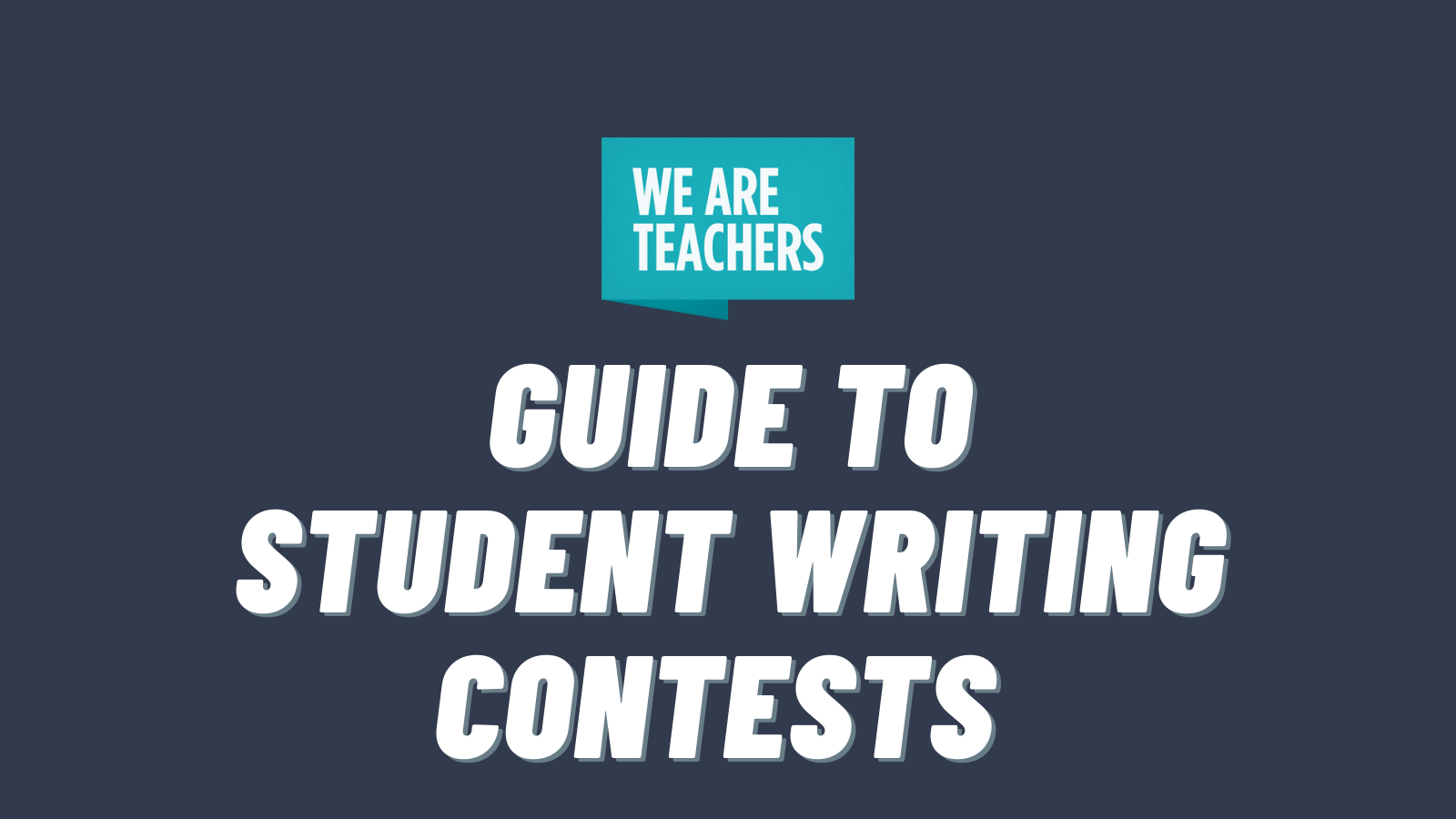
When students write for teachers, it can feel like an assignment. When they write for a real purpose, they are empowered! Student writing contests are a challenging and inspiring way to try writing for an authentic audience— a real panel of judges —and the possibility of prize money or other incentives. We’ve gathered a list of the best student writing contests, and there’s something for everyone. Prepare highly motivated kids in need of an authentic writing mentor, and watch the words flow.
1. The Scholastic Art & Writing Awards
With a wide range of categories—from critical essays to science fiction and fantasy—The Scholastic Awards are a mainstay of student contests. Each category has its own rules and word counts, so be sure to check out the options before you decide which one is best for your students.
How To Enter
Students in grades 7-12, ages 13 and up, may begin submitting work in September by uploading to an online account at Scholastic and connecting to their local region. There are entry fees, but those can be waived for students in need.
2. YoungArts National Arts Competition
This ends soon, but if you have students who are ready to submit, it’s worth it. YoungArts offers a national competition in the categories of creative nonfiction, novel, play or script, poetry, short story, and spoken word. Student winners may receive awards of up to $10,000 as well as the chance to participate in artistic development with leaders in their fields.
YoungArts accepts submissions in each category through October 13. Students submit their work online and pay a $35 fee (there is a fee waiver option).
3. National Youth Foundation Programs
Each year, awards are given for Student Book Scholars, Amazing Women, and the “I Matter” Poetry & Art competition. This is a great chance for kids to express themselves with joy and strength.
The rules, prizes, and deadlines vary, so check out the website for more info.
4. American Foreign Service National High School Essay Contest
If you’re looking to help students take a deep dive into international relations, history, and writing, look no further than this essay contest. Winners receive a voyage with the Semester at Sea program and a trip to Washington, DC.
Students fill out a registration form online, and a teacher or sponsor is required. The deadline to enter is the first week of April.
5. John F. Kennedy Profile in Courage Essay Contest
This annual contest invites students to write about a political official’s act of political courage that occurred after Kennedy’s birth in 1917. The winner receives $10,000, and 16 runners-up also receive a variety of cash prizes.
Students may submit a 700- to 1,000-word essay through January 12. The essay must feature more than five sources and a full bibliography.
6. Bennington Young Writers Awards
Bennington College offers competitions in three categories: poetry (a group of three poems), fiction (a short story or one-act play), and nonfiction (a personal or academic essay). First-place winners receive $500. Grab a poster for your classroom here .
The contest runs from September 1 to November 1. The website links to a student registration form.
7. The Princeton Ten-Minute Play Contest
Looking for student writing contests for budding playwrights? This exclusive competition, which is open only to high school juniors, is judged by the theater faculty of Princeton University. Students submit short plays in an effort to win recognition and cash prizes of up to $500. ( Note: Only open to 11th graders. )
Students submit one 10-page play script online or by mail. The deadline is the end of March. Contest details will be published in early 2024.
8. Princeton University Poetry Contest for High School Students
The Leonard L. Milberg ’53 High School Poetry Prize recognizes outstanding work by student writers in 11th grade. Prizes range from $100 to $500.
Students in 11th grade can submit their poetry. Contest details will be published this fall.
9. The New York Times Tiny Memoir Contest
This contest is also a wonderful writing challenge, and the New York Times includes lots of resources and models for students to be able to do their best work. They’ve even made a classroom poster !
Submissions need to be made electronically by November 1.
10. Nancy Thorp Poetry Contest
The deadline for this contest is the end of October. Sponsored by Hollins University, the Nancy Thorp Poetry Contest awards prizes for the best poems submitted by young women who are sophomores or juniors in high school or preparatory school. Prizes include cash and scholarships. Winners are chosen by students and faculty members in the creative writing program at Hollins.
Students may submit either one or two poems using the online form.
11. The Patricia Grodd Poetry Prize for Young Writers
The Patricia Grodd Poetry Prize for Young Writers is open to high school sophomores and juniors, and the winner receives a full scholarship to a Kenyon Review Young Writers Workshop .
Submissions for the prize are accepted electronically from November 1 through November 30.
12. Jane Austen Society Essay Contest
High school students can win up to $1,000 and publication by entering an essay on a topic specified by the Jane Austen Society related to a Jane Austen novel.
Details for the 2024 contest will be announced in November. Essay length is from six to eight pages, not including works cited.
13. Rattle Young Poets Anthology
Open to students from 15 to 18 years old who are interested in publication and exposure over monetary awards.
Teachers may choose five students for whom to submit up to four poems each on their behalf. The deadline is November 15.
14. The Black River Chapbook Competition
This is a chance for new and emerging writers to gain publication in their own professionally published chapbook, as well as $500 and free copies of the book.
There is an $18 entry fee, and submissions are made online.
15. YouthPlays New Voices
For students under 18, the YouthPlays one-act competition is designed for young writers to create new works for the stage. Winners receive cash awards and publication.
Scroll all the way down their web page for information on the contest, which accepts non-musical plays between 10 and 40 minutes long, submitted electronically. Entries open each year in January.
16. The Ocean Awareness Contest
The 2024 Ocean Awareness Contest, Tell Your Climate Story , encourages students to write their own unique climate story. They are asking for creative expressions of students’ personal experiences, insights, or perceptions about climate change. Students are eligible for a wide range of monetary prizes up to $1,000.
Students from 11 to 18 years old may submit work in the categories of art, creative writing, poetry and spoken word, film, interactive media and multimedia, or music and dance, accompanied by a reflection. The deadline is June 13.
17. EngineerGirl Annual Essay Contest
Each year, EngineerGirl sponsors an essay contest with topics centered on the impact of engineering on the world, and students can win up to $500 in prize money. This contest is a nice bridge between ELA and STEM and great for teachers interested in incorporating an interdisciplinary project into their curriculum. The new contest asks for pieces describing the life cycle of an everyday object. Check out these tips for integrating the content into your classroom .
Students submit their work electronically by February 1. Check out the full list of rules and requirements here .
18. NCTE Student Writing Awards
The National Council of Teachers of English offers several student writing awards, including Achievement Awards in Writing (for 10th- and 11th-grade students), Promising Young Writers (for 8th-grade students), and an award to recognize Excellence in Art and Literary Magazines.
Deadlines range from October 28 to February 15. Check out NCTE.org for more details.
19. See Us, Support Us Art Contest
Children of incarcerated parents can submit artwork, poetry, photos, videos, and more. Submissions are free and the website has a great collection of past winners.
Students can submit their entries via social media or email by October 25.
20. The Adroit Prizes for Poetry & Prose
The Adroit Journal, an education-minded nonprofit publication, awards annual prizes for poetry and prose to exceptional high school and college students. Adroit charges an entry fee but also provides a form for financial assistance.
Sign up at the website for updates for the next round of submissions.
21. National PTA Reflections Awards
The National PTA offers a variety of awards, including one for literature, in their annual Reflections Contest. Students of all ages can submit entries on the specified topic to their local PTA Reflections program. From there, winners move to the local area, state, and national levels. National-level awards include an $800 prize and a trip to the National PTA Convention.
This program requires submitting to PTAs who participate in the program. Check your school’s PTA for their deadlines.
22. World Historian Student Essay Competition
The World Historian Student Essay Competition is an international contest open to students enrolled in grades K–12 in public, private, and parochial schools, as well as those in home-study programs. The $500 prize is based on an essay that addresses one of this year’s two prompts.
Students can submit entries via email or regular mail before May 1.
23. NSHSS Creative Writing Scholarship
The National Society of High School Scholars awards three $2,000 scholarships for both poetry and fiction. They accept poetry, short stories, and graphic novel writing.
Apply online by October 31.
Whether you let your students blog, start a podcast or video channel, or enter student writing contests, giving them an authentic audience for their work is always a powerful classroom choice.
If you like this list of student writing contests and want more articles like it, subscribe to our newsletters to find out when they’re posted!
Plus, check out our favorite anchor charts for teaching writing..
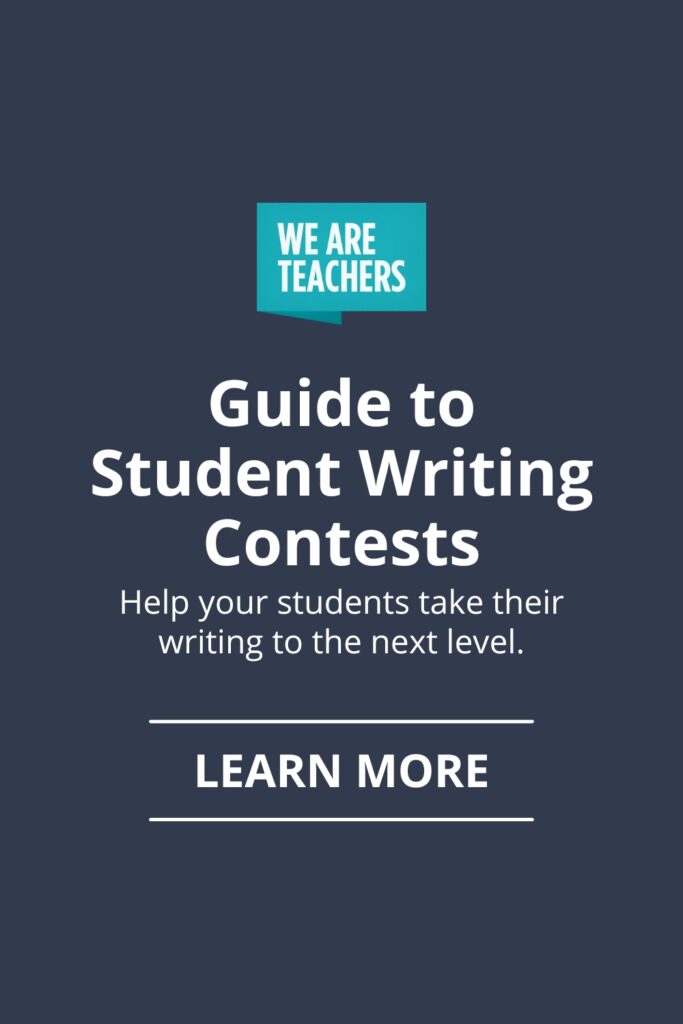
You Might Also Like

Best 2024 Competitions for Students in Grades K-12
Competitions in STEM, ELA and the arts, and more! Continue Reading
Copyright © 2024. All rights reserved. 5335 Gate Parkway, Jacksonville, FL 32256
Expedia Rewards is now One Key™
Elektrostal, visit elektrostal, check elektrostal hotel availability, popular places to visit.
- Electrostal History and Art Museum
You can spend time exploring the galleries in Electrostal History and Art Museum in Elektrostal. Take in the museums while you're in the area.
- Cities near Elektrostal

- Places of interest
- Yuri Gagarin Cosmonaut Training Center
- Central Museum of the Air Forces at Monino
- Peter the Great Military Academy
- History of Russian Scarfs and Shawls Museum
- Ramenskii History and Art Museum
- Bykovo Manor
- Pekhorka Park
- Balashikha Arena
- Malenky Puppet Theater
- Drama Theatre BOOM
- Balashikha Museum of History and Local Lore
- Pavlovsky Posad Museum of Art and History
- Saturn Stadium
- Church of Vladimir
- Likino Dulevo Museum of Local Lore
- Orekhovo Zuevsky City Exhibition Hall
- Noginsk Museum and Exhibition Center
- Fairy Tale Children's Model Puppet Theater
- Fifth House Gallery
- Malakhovka Museum of History and Culture
Current time by city
For example, New York
Current time by country
For example, Japan
Time difference
For example, London
For example, Dubai
Coordinates
For example, Hong Kong
For example, Delhi
For example, Sydney
Geographic coordinates of Elektrostal, Moscow Oblast, Russia
City coordinates
Coordinates of Elektrostal in decimal degrees
Coordinates of elektrostal in degrees and decimal minutes, utm coordinates of elektrostal, geographic coordinate systems.
WGS 84 coordinate reference system is the latest revision of the World Geodetic System, which is used in mapping and navigation, including GPS satellite navigation system (the Global Positioning System).
Geographic coordinates (latitude and longitude) define a position on the Earth’s surface. Coordinates are angular units. The canonical form of latitude and longitude representation uses degrees (°), minutes (′), and seconds (″). GPS systems widely use coordinates in degrees and decimal minutes, or in decimal degrees.
Latitude varies from −90° to 90°. The latitude of the Equator is 0°; the latitude of the South Pole is −90°; the latitude of the North Pole is 90°. Positive latitude values correspond to the geographic locations north of the Equator (abbrev. N). Negative latitude values correspond to the geographic locations south of the Equator (abbrev. S).
Longitude is counted from the prime meridian ( IERS Reference Meridian for WGS 84) and varies from −180° to 180°. Positive longitude values correspond to the geographic locations east of the prime meridian (abbrev. E). Negative longitude values correspond to the geographic locations west of the prime meridian (abbrev. W).
UTM or Universal Transverse Mercator coordinate system divides the Earth’s surface into 60 longitudinal zones. The coordinates of a location within each zone are defined as a planar coordinate pair related to the intersection of the equator and the zone’s central meridian, and measured in meters.
Elevation above sea level is a measure of a geographic location’s height. We are using the global digital elevation model GTOPO30 .
Elektrostal , Moscow Oblast, Russia

IMAGES
VIDEO
COMMENTS
An easy lesson plan for creative writing that will pay off later is to activate prior knowledge. Brainstorm creative, memorable, unforgettable stories with students. Share your thoughts too! You will start to build relationships with students who share the same tastes as you (and those that are completely different!).
Middle School Writing Lessons. So what's in our lesson plans? Check it out: 1: Who's the Goat: Debating the Greatest of All Time. 2: Mapping the Neighborhood: Creating Maps to Generate Story Ideas. 3: My Obituary: The Story of Your Life. 4: Double, Double, Toil & Trouble: Writing Recipes for Magic Potions. 5: My Principal is an Alien ...
Whatever the case may be, these 20 creative writing activities for middle school will have all of your students showing their creative prowess. 1. I Am From ... Following this lesson plan, your students will be able to write their own simple yet eloquent poems and feel like accomplished writers. Learn More: NYLearns.
Prompts for Exploring Emotions. The Joy of Finding a Lost Toy. Revisit a childhood memory of losing a cherished toy and the overwhelming happiness of eventually finding it. A Moment of Overcoming Fear. Write about when you faced a fear head-on and emerged stronger and braver on the other side. The Bittersweet Farewell.
Lacking inspiration for a middle school writing project? Get your pencil moving with 100 varied creative prompts for narrative, informational, argument, and poetry writing. ... 100 Creative Writing Prompts for Middle School By Jennifer Gunner, M.Ed. Education , Senior Writer . Updated May 19, 2021 Image Credits.
Here are five lesson plans from the 2022-2023 school year for middle and high school students, from our Writing the Community teaching artists!. A Poem About Joy: In this lesson plan, inspired by Ross Gay's "Sorrow Is Not My Name," Teré Fowler-Chapman asks young poets to come up with a list of things that bring them joy and then write a poem inspired by one of the items on that list.
Here are 10 of our favorite story telling activities that inspire students: 1. Write an "I am from" poem. Students read the poem "I am From" by George Ella Lyon. Then, they draft a poem about their own identity in the same format Lyon used. Finally, students create a video to publish their poems.
The "I Remember" Poem. Students use personal experience to write creatively in this poetry lesson plan. They'll think back and choose a dozen…. Subjects: Reading and Literature. Poetry. Creative Writing. Download. Add to Favorites.
Middle school writing lessons can be found in this blog post. Writing is a pillar of an ELA classroom. Keep your foundation strong with new ideas and inspiration. ... Creative Writing Lesson Ideas. It can be hard to remember that students enjoy the opportunity to flex their creative muscles with creative writing assignments. In this blog post ...
Our 2020-21 Writing Curriculum for Middle and High School. A flexible, seven-unit program based on the real-world writing found in newspapers, from editorials and reviews to personal narratives ...
Creative Writing Exercises for Middle School. Instructor Nicky Davis. Cite this lesson. Creative writing exercises are a fun and interesting way to improve your writing skill. Keep reading to find ...
8. Out of a Hat. Teach your students about the components of different literary forms by discussing writing styles (narrative, expository, descriptive, and persuasive). Write each form on a small piece of paper and, you guessed it, toss it in a hat (or a bucket or any type of container).
6 Ways to Teach Writing reatively Teach your students the fun aspects of writing. Students of all ages write short stories and papers, from younger elementary-school writers through college-age students.
Creative Writing Lesson Plans. April 15, 2020 / Writing. Creative writing is an important writing style for students to learn about and experience on their journey to becoming writers. Helping students embrace their creativity is a great way to get students writing. Students enjoy writing more when they get choice over their topic and format.
In the middle school world, non-fiction is the primary focus of classroom writing. Therefore, a creative writing unit can provide a breath of fresh air. This unit guides students through a step-by ...
By the Old Mill Stream A creative writing prompt, differentiated for elementary and middle and high school students. Students begin writing a narrative. In the second part of the prompt, they write a description. Calling on the Muse: Exercises to Unlock the Poet Within From Education World. Can You Haiku? from EdSitement Complete lesson plans ...
Writer's workshop is a method of teaching writing developed by Donald Graves and Donald Murray, amongst other teacher-researchers. The writer's workshop provides a student-centered environment where students are given time, choice, and voice in their learning. The teacher nurtures the class by creating and mentoring a community of writers.
4.8. (43) $17.00. Zip. Google Apps™. This Creative Writing Workbook includes 25+ different creative writing projects + activities for students to complete! It is designed for grades 6-12 and includes student descriptions, student examples, brainstorming pages, and rubrics for each project!This resource provides teachers with a unique way to ...
This Creative Writing Workbook includes 25+ different creative writing projects + activities for students to complete! It is designed for grades 6-12 and includes student descript
Students in 11th grade can submit their poetry. Contest details will be published this fall. 9. The New York Times Tiny Memoir Contest. This contest is also a wonderful writing challenge, and the New York Times includes lots of resources and models for students to be able to do their best work.
Pool «Kristall» - school of the Olympic reserve: diving, synchronized swimming, swimming. Home arena hockey team Kristall Elektrostal - Ledovyi Dvorets Sporta «Kristall» in 1995 year. The city ice hockey team Kristall Elektrostal was established in 1949 and plays in the Junior Hockey League Division B. Notable people Nikolay Vtorov Street
Animals and Pets Anime Art Cars and Motor Vehicles Crafts and DIY Culture, Race, and Ethnicity Ethics and Philosophy Fashion Food and Drink History Hobbies Law Learning and Education Military Movies Music Place Podcasts and Streamers Politics Programming Reading, Writing, and Literature Religion and Spirituality Science Tabletop Games ...
Cities near Elektrostal. Places of interest. Pavlovskiy Posad Noginsk. Travel guide resource for your visit to Elektrostal. Discover the best of Elektrostal so you can plan your trip right.
Geographic coordinates of Elektrostal, Moscow Oblast, Russia in WGS 84 coordinate system which is a standard in cartography, geodesy, and navigation, including Global Positioning System (GPS). Latitude of Elektrostal, longitude of Elektrostal, elevation above sea level of Elektrostal.